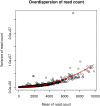Differentially expressed heterogeneous overdispersion genes testing for count data
- PMID: 39018275
- PMCID: PMC11253971
- DOI: 10.1371/journal.pone.0300565
Differentially expressed heterogeneous overdispersion genes testing for count data
Abstract
The mRNA-seq data analysis is a powerful technology for inferring information from biological systems of interest. Specifically, the sequenced RNA fragments are aligned with genomic reference sequences, and we count the number of sequence fragments corresponding to each gene for each condition. A gene is identified as differentially expressed (DE) if the difference in its count numbers between conditions is statistically significant. Several statistical analysis methods have been developed to detect DE genes based on RNA-seq data. However, the existing methods could suffer decreasing power to identify DE genes arising from overdispersion and limited sample size, where overdispersion refers to the empirical phenomenon that the variance of read counts is larger than the mean of read counts. We propose a new differential expression analysis procedure: heterogeneous overdispersion genes testing (DEHOGT) based on heterogeneous overdispersion modeling and a post-hoc inference procedure. DEHOGT integrates sample information from all conditions and provides a more flexible and adaptive overdispersion modeling for the RNA-seq read count. DEHOGT adopts a gene-wise estimation scheme to enhance the detection power of differentially expressed genes when the number of replicates is limited as long as the number of conditions is large. DEHOGT is tested on the synthetic RNA-seq read count data and outperforms two popular existing methods, DESeq2 and EdgeR, in detecting DE genes. We apply the proposed method to a test dataset using RNAseq data from microglial cells. DEHOGT tends to detect more differently expressed genes potentially related to microglial cells under different stress hormones treatments.
Copyright: © 2024 Yuan et al. This is an open access article distributed under the terms of the Creative Commons Attribution License, which permits unrestricted use, distribution, and reproduction in any medium, provided the original author and source are credited.
Conflict of interest statement
The authors have declared that no competing interests exist.
Figures
























Update of
-
Differentially Expressed Heterogeneous Overdispersion Genes Testing for Count Data.bioRxiv [Preprint]. 2023 Feb 22:2023.02.21.529455. doi: 10.1101/2023.02.21.529455. bioRxiv. 2023. Update in: PLoS One. 2024 Jul 17;19(7):e0300565. doi: 10.1371/journal.pone.0300565. PMID: 36865247 Free PMC article. Updated. Preprint.
Similar articles
-
Differentially Expressed Heterogeneous Overdispersion Genes Testing for Count Data.bioRxiv [Preprint]. 2023 Feb 22:2023.02.21.529455. doi: 10.1101/2023.02.21.529455. bioRxiv. 2023. Update in: PLoS One. 2024 Jul 17;19(7):e0300565. doi: 10.1371/journal.pone.0300565. PMID: 36865247 Free PMC article. Updated. Preprint.
-
A two-step integrated approach to detect differentially expressed genes in RNA-Seq data.J Bioinform Comput Biol. 2016 Dec;14(6):1650034. doi: 10.1142/S0219720016500347. Epub 2016 Sep 15. J Bioinform Comput Biol. 2016. PMID: 27774870
-
Robust identification of differentially expressed genes from RNA-seq data.Genomics. 2020 Mar;112(2):2000-2010. doi: 10.1016/j.ygeno.2019.11.012. Epub 2019 Nov 20. Genomics. 2020. PMID: 31756426
-
Detecting differentially expressed genes by smoothing effect of gene length on variance estimation.J Bioinform Comput Biol. 2015 Dec;13(6):1542004. doi: 10.1142/S0219720015420044. Epub 2015 Oct 11. J Bioinform Comput Biol. 2015. PMID: 26608751
-
Statistical detection of differentially expressed genes based on RNA-seq: from biological to phylogenetic replicates.Brief Bioinform. 2016 Mar;17(2):243-8. doi: 10.1093/bib/bbv035. Epub 2015 Jun 24. Brief Bioinform. 2016. PMID: 26108230 Review.
References
-
- Zhang H, Pounds SB, Tang L. Statistical methods for overdispersion in mRNA-Seq count data. The Open Bioinformatics Journal. 2013;7(1). doi: 10.2174/1875036201307010034 - DOI
MeSH terms
Substances
Grants and funding
LinkOut - more resources
Full Text Sources

